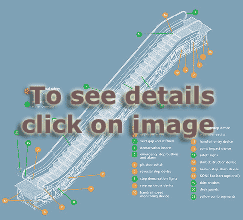Escalator Basics Today: How to Plan, Design and Update
New technology and code revisions plus the absence of standard building interface dimensions require a project by project approach to escalator design.
![]() Continuing Education
Continuing Education
Use the following learning objectives to focus your study while reading this month’s Continuing Education article.
Learning Objectives - After reading this article, you will be able to:
- Summarize the design concepts, building interface basics and essential components for escalator installation.
- Identify the pertinent features necessary for optimum escalator planning.
- Evaluate the different options available for updating escalators.
U.S. patents for escalators or moving stairways date back to the mid 19th century, but it was not until the late 1800s that the world's first operable escalator was installed in Coney Island, New York and London's Harrods department store. Shortly thereafter the first commercial model appeared in 1900 and during the first half of the 20th century manufacturers in both the U.S. and Europe found a welcome market for their models.
Since then, with improved technology, escalators have routed people within virtually every building type from hotels to department stores and transported the public in airports, office buildings and even outdoors. The world's longest system is the 2,600 ft Central- Mid-Levels escalator in Hong Kong, which transports tens of thousands of commuters between their work and residence above the streets.
Yet escalators do more than efficiently move 90-plus billion passengers each year. They encourage communication. Environmental psychologists have noticed that conversations are broken off at the arrival of the elevator and recommend that creative corporations specifically request escalators for new offices. Escalators also offer a unique organizational view that counteracts the isolation experienced by executives on penthouse floors. While new construction is the major market for escalators, renovation and replacement is a growing sector, since an increasing number of the estimated 50,000 escalators in the U.S. are over 20 years old.
Escalators are not created equally and are unlikely to fit the same well way. U.S. code requires the angle of inclination not to exceed 30 degrees and while most manufacturers use similar escalator components, each manufacturer arranges these components differently.
An understanding of their design concepts and installation requirements ? and how their functioning varies according to the kind of project ? is therefore key to designing escalators for both new and existing buildings. In addition, with the drive towards sustainable design, awareness of energy efficiencies and environmental issues in escalator design is becoming increasingly critical.
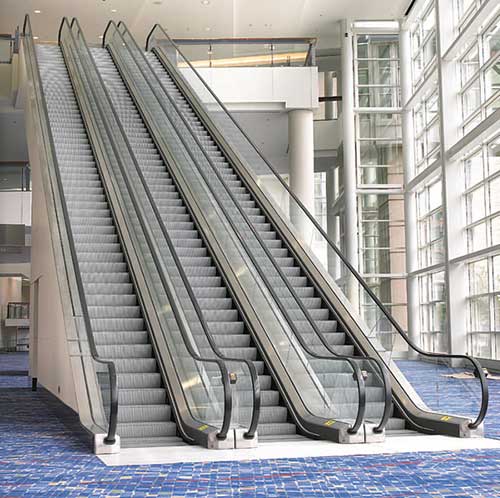 |
Photo courtesy KONE Inc. |
Â
BASIC ESCALATOR COMPONENTS
The essential components of an escalator include:
The structural truss. A truss is the main supporting structure of the escalator that bridges the lower and upper landings, composed of two side sections joined together with cross braces across the bottom and top of the structure. The ends of the truss are attached to the top and bottom landing platforms via steel or concrete supports. The truss carries all the straight track sections connecting the upper and lower modules.
Upper module step and handrail drive system, the main electrical and mechanical drive, is generally housed beneath thetop landing platform at the upper end of the unit.
| Escalator Components |
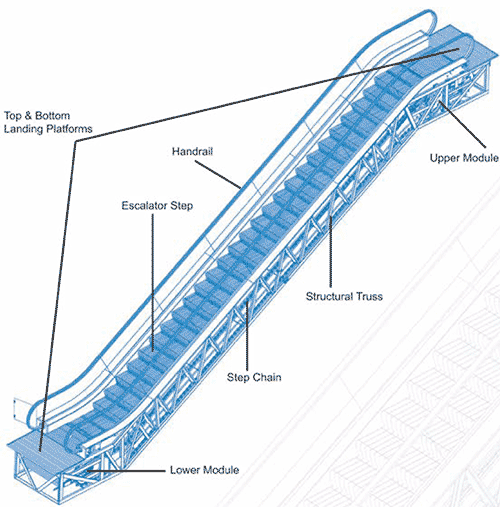 |
Source: KONE Inc. |
Â
Early technology drive systems used worm gear drives that were about 70 percent efficient. They used a handrail drive chain/ linkage which, in turn, required high maintenance and messy oiling. In addition slippage often occurred because of faulty synchronization.
New technology drive systems are about 94 percent efficient and employ a planetary gear drive, which eliminates the handrail drive chain, messy oiling and synchronization problems. The planetary gear drive uses synthetic-based lubrication and has a 30,000-hour run before the oil needs to be changed, about twice that of conventional sytems.
Electrical drive systems have improved as well. Full voltage systems that required high amperage to start have been replaced with solid state soft-starting controls.
Many manufacturers also offer sensing devices, which monitor the load on the escalator and adjust motor voltage accordingly. This can result in electrical cost savings of up to 40 percent over conventional escalator systems.
The lower modulehouses the step return idler sprockets or lower reversing station. This lower reversing station component is now manufactured in cast steel, allowing for a quieter and smoother transition of the steps and chain around the lower end of the escalator.
Top and bottom landing platforms.In addition to housing the upper and lower modules, the top and bottom platforms anchor the ends of the escalator truss and contain a floor plate, a comb plate and comb segments. The floor plate provides a place for the passengers to stand before they step onto the moving stairs. This plate is flush with the finished floor and is either hinged or removable to allow easy access to the machinery below. The comb plate is the piece between the stationary floor plate and the moving step. The comb segments are mounted to the comb plate and are so named because their edge resembles the teeth of a comb. These teeth mesh with matching treads on the top of the steps. This design is necessary to minimize the gap between the escalator steps and the comb plate, which helps eliminate entrapments.
Step chain. Each escalator contains two step chains on either side of the unit. These are basically similar in shape to a bicycle chain, but much larger, and attach the steps to the mechanical drive system which continuously pulls the steps.
Historically these chains required constant lubrication, consuming up to 600 liters of oil in a 10-year period. Further, they made for an oily mess throughout the interior of the escalator that required regular clean downs that used strong solvents and detergents. Most manufacturers now offer a patented lubricationfree chain as a standard or as an option. These dramatically reduce oil consumption, eliminate problematic oiling devices, prevent environmental contamination and significantly cut downtime associated with housekeeping and maintenance.
The tracks.The track system is built into the truss to guide the steps. There are actually two tracks: one for the front wheels of the steps and one for the back wheels of the steps. The relative positions of these tracks cause the steps to form a staircase as they move out from under the comb plate. On the inclined portion of the escalators, the step track is positioned to create a staircase configuration at the steps. Then, as the steps transition at the top and bottom of the escalator, the two tracks separate to allow the steps to "flatten out" at the floor plate.
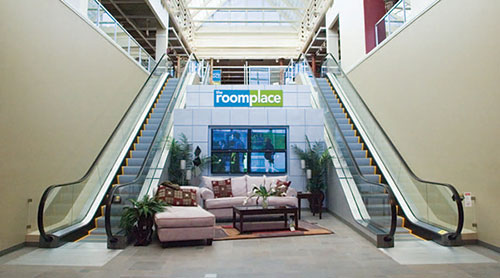 |
| Photo courtesy KONE Inc. |
Â
Escalator steps. Most manufacturers offer steps in three widths: 24-in, 32-in and 40-in wide. The depth of any step tread in the direction of travel shall not be less than 400mm (15.75in) and the rise between treads shall not be more than 220mm (8.5in). Most steps today are fabricated from cast aluminum, which is stronger and lighter than older escalator step construction.
The handrail. As its name declares, the handrail provides a convenient handhold for passengers. Manufacturers offer a range of colors to provide an aesthetic fit.
| Escalator Modernization |
Maintained by the Port Authority of New York and New Jersey, the George Washington Bridge Bus Station has three levels?the main concourse with shops and ticket sales, the lower level with local bus and subway stops and bus platforms on the upper level. Escalators moving people between each level had been in service since the station was opened in 1963. After 40 years of heavy use, equipment malfunctions, lack of spare parts and addressing safety code changes, escalators were periodically taken out of service, thereby seriously inconveniencing the station's 20,000 daily commuters. Two alternatives were evaluated: rehabilitation and replacement, reports Port Authority engineers Dharam Pai, PE and Cheng Chang, PE. Each alternative was problematic. New replacement parts were hard to obtain and replacing the existing heavy-duty escalators required significantly more space that involved structural modifications. While exploring these options, a third was presented: a modernization package where an entirely new escalator would be installed in the existing truss. The package provided a systematic way of replacing all escalator components with new custom engineered modular ASME code and New York City building code compliant components, while avoiding significant disruptions and construction costs. Two escalators were selected as a pilot project. After extensive factory testing (the modernization was the first for the station's type of escalator) the modules were attached to the existing truss. Other components were installed in sequential fashion that followed the procedures of new escalator construction. No structural modifications were required and no major rigging, hoisting or crane requirements were necessary ? and no service interruptions. Cited as a 2007 Project of the Year by Elevator World, the two modernized escalators offer improved safety, greater reliability, lower energy use and lower operating costs. Moreover, the replacement newels, decking and stainless steel balustrades improve the appearance of the station. |
Â
ESCALATOR DESIGN CONCEPTS
Escalator geometry. Governed by ASME and CSA (Canadian Standards Association) standards in the U.S. and Canada (ASME A17.1-2007/CSA B44-07 Safety Code for Elevators and Escalators), A17.1 requires the angle of inclination for escalators not to exceed 30 degrees. (Old/historic escalators must conform to the requirements of ASME A17.3 as a minimum, where adopted by the local authority.)
This means that for a given floor to floor rise, the work point (WP) ? the point at which the 30 degree incline intersects with the floor level ? to work point (WP) dimension is always the same, regardless of the manufacturer (floor to floor rise x 1.73205.)
Since manufacturers configure escalator components differently, the distance between the floor level WP and the point at which the escalator intersects with the building structure ? known as the Face of Support (FOS) ? varies. As a result, all manufacturers' space requirements between the WP and FOS have different dimensions.
| Escalator Geometry |
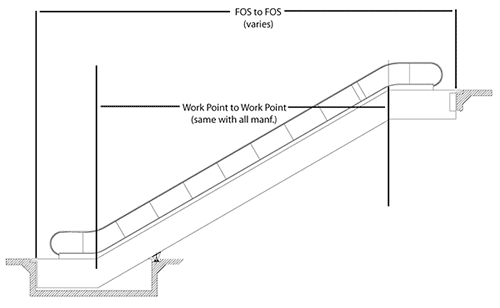 |
Source: KONE Inc. |
Â
Interfacing with the building. The distance between the FOS at the upper end and the FOS at the lower end formulates the actual structural opening of the escalator well-way. Then, an 8" pocket is typically provided at each landing to allow for the alignment of plate finishes with the walk-on plate.
| Building Interface: Face of Support Details |
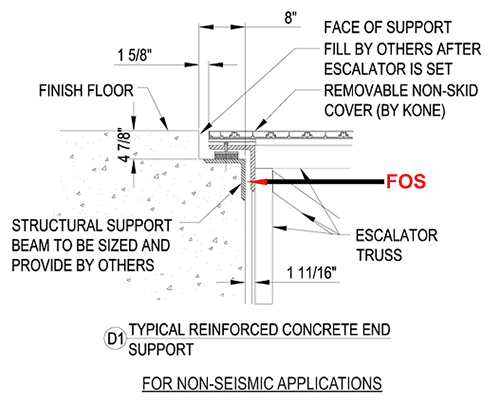 |
Source: KONE Inc. |
Â
The depth and length of the pit, number of level steps and whether or not intermediate support is required at the back of the escalator pit will all vary from manufacturer to manufacturer, depending upon the rise of the escalator and width of the steps.
| Building Interface: Pit Depth, Length and Intermediate Support Insert |
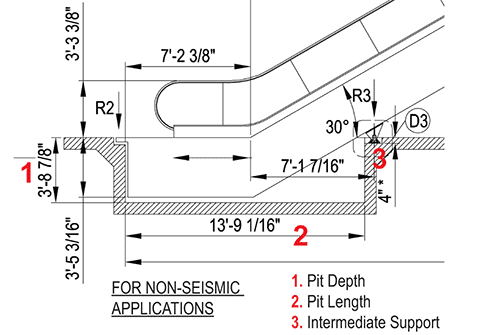 |
Source: KONE Inc. |
Â
The width of the escalator pit is typically calculated as the physical width of the escalator plus two inches to allow for construction tolerance. Side by side escalators are typically handled the same way, but the two inches is added only once, not per escalator.
Code stipulates the width and the length of the landing zone at each end of the escalator, both of which are driven by the distance between the centerline of the handrails (CLHR.) This varies with step width and among manufacturers.
Â
| Code Clearances |
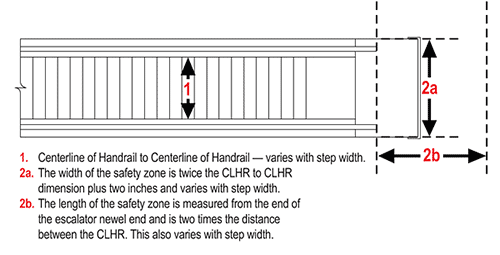 |
Source: KONE Inc. |
Â
Standard escalator features. Most escalator manufacturers offer the following basic standard features:
Balustrades in "solid" usually #4 or #8 stainless steel and bronze or glass with thickness either 3/8" or 1/2".
Speed. 100 ft per minute, which is the maximum speed.
Step widths in 24-in, 32-in and 40-in.
Microprocessor based controller.
Maximum travel distance varies with manufacturer.
Painted steps in silver and black
High-impact step inserts in yellow and black
Floor Plate in aluminum and stainless steel
Safety features. (See Safety Features sidebar below.)
ESCALATOR PLANNING
The essential feature of escalator planning is to understand that there is no one-solution-fits-all. Each project needs to be analyzed according to its particular requirements.
Applications for Escalators with Different Step Widths |
||||
Size |
Step Width |
Single-step capacity |
Applications |
Energy consumption in Horsepower |
Small |
24 in |
One passenger |
Two passengers - one may walk past another |
5 HP |
Medium |
32 in |
One passenger + one package or one piece of luggage |
Two passengers - one may walk past another |
10 HP |
Large |
40 in |
Two passengers - one may walk past another |
Mainstay of metro systems, larger airports, train stations, some retail usage |
15 HP |
Â
The first place to start is analyzing the market segment. Retail, office, airport, stadium, hospital or public transit, each require different features and design aesthetics. Some site-driven features include:
- Type of balustrade. In addition to standard manufacturer offerings stainless steel, bronze and glass, detailing in brass and ambient glass are available.
- Step width is specified according to space available and the requirements of passengers.
- Number of flat steps. Code requires a minimum of two flat steps. Most commercial projects are designed for two flat steps. Three flat steps is a common feature found in public transportation projects.
- Weather related features. Water resistant options include galvanized trusses, water tight control cabinets and electrical switches, sealed bearings, chain covers, and protective canopies. These are common in outdoor applications.
- Type of chain. Lubricated chain or lubrication free chain are options. Depending on the rise, width, and step loading requirements, chain will be sized accordingly.
- Type of metal finish. 304 type steel is standard. 316 is an available option for corrosion resistance.
- Type of drive and other components. Planetary gear drives are standard. Energy saving soft start devices are optional.
Since many of these features can add considerable cost to the escalator budget, it is important to take time to match the operating environment with the required features prior to finalizing the project budget and specification.
Â
ESCALATOR REPLACEMENT
Industry estimates note that as many as 30,000 of existing escalators are 20 years old or more and are in need of updating. There are several reasons why: moving parts wear out over time, decreasing reliability and life span, changes to safety codes, replacing old parts with often-unavailable ?new' old parts becomes costly, etc. In addition, the efficiency, smoothness and reliability of new equipment set a higher standard so that older escalators appear painfully slow.
Perhaps the most important reason to update is that new technology has improved efficiency. New motors and drives require less electrical usage. Most of the starters on units over 15 years old employ a full voltage Wye Start/Delta Run connection that requires a higher starting and running amperage. New types of power control offered as options by manufacturers adjusts the motor power to the number of riders using the escalator while maintaining normal speed. Combined with a solid-state soft-start it can reduce electricity use by a significant amount. A study conducted by Nevada Power prepared by Paragon Consulting Services found electrical consumption was reduced by up to 40 percent.
There are two basic full replacement options for owners and design consultants seeking to update old escalators ? direct replacement or complete modernization. Again, each project must be evaluated on its own merits to determine which approach is appropriate. Different conditions require different solutions.
Replacement: Factors to consider
? Location. Does access for getting the old units out and the new
units in even exist?
? Building occupancy. How will complete replacement impact
traffic flow in the existing building? What will be the cost of doing
business during replacement?
? Work by others. How much general contractor work is required in
order to tear out and remove the existing units?
? Impact to finishes. How will removing existing units, construction
and installing new units impact existing finishes within the
building?
? Other factors to consider. How will additional security, housekeeping,
and so forth, impact the budget and the building occupants?
? All factors must be looked at closely in order to come up with best
overall value to the client.
Replacement: The Process
Since escalators become part of the foundation of a building structure,
removing and replacing them can turn into a much larger
project than first considered. Each stage from prep-work through
wrap-up needs to be quantified.
| Escalator Replacement Modules |
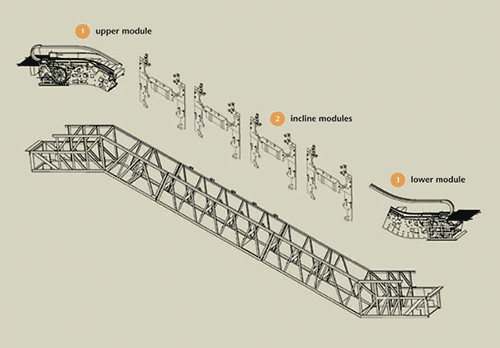 |
Source: KONE Inc. |
Â
Prep-work required before the removal of the existing trusses includes installing OSHA-approved barricades around the entire escalator well way; protection of flooring; removal of all existing escalator cladding; demolition of adjacent finishes; demolition of adjacent features; installation of scaffolding.
Removal includes the removal of sprinklers and water lines, all electrical wiring, ventilation and ducts; and the concrete and tile surrounding the escalator access covers.
The major work is the demolition and removal of existing structural steel escalator truss, usually at overtime rates. The truss typically needs to be laid down flat and cut into pieces for removal from the building. In many cases, the existing pits need to be torn out and replaced since new escalators will require a different well-way size from the existing ones. Sprinklers and water lines may also need to be removed and re-installed.
Installation. New escalator trusses are brought into the building in pieces, married together on the floor and then hoisted into the newly constructed well ways.
Wrap-up. All finishes and features torn out in order to allow access for the new equipment must then be rebuilt or replaced before the new escalators can be put into service; the flooring repaired at the newly reconstructed pit; removal of scaffolding and barricades; ceramic or carpet replacement.
Builder risk insurance, city impact fees, architect/engineer design fees add to the cost, as does the additional work by the trades for replacing fire and sprinkler systems, lighting and HVAC. In many cases the work of the general contractor and by others can be more than the cost of the escalators.
Escalator modernization
Modernization, in essence, is removing all of the existing internal
components of the escalator, while keeping the truss, and replacing them with brand new escalator technology. The end result is a
new escalator without the time and expense of all the construction
associated with a full replacement.
Modernization is often far less disruptive to the surrounding building operations and it is often possible to keep one escalator running while the other is being modernized.
The modernization process starts with stripping the existing escalator down to the structural steel truss. No adjoining finishes are removed or damaged and the need for most of the general contractor work associated with a full replacement is eliminated.
Modernization installation sequence
? Small barricades are installed around the upper and lower ends of
the escalator. As one of the side by side pair of escalators is being
modernized, a protective barricade is also installed between the
two units.
? All internal components are removed from the old escalator. The
torn out components are recycled when feasible. The truss and all
other attached finishes are reused.
? Upper and lower end modules are set in place and aligned.
? Incline modules are then installed to the existing truss cross
members. Step tracks are also installed throughout the entire
length of the unit.
? Step chain and escalator steps are installed and the unit is put
under a test run.
? Architectural features such as decking and balustrade panels are
installed next.
? Finally, the handrails are installed and the units are cleaned and
turned over for use.
In many cases, Escalator Modernization offers the best value solution for many customers when all final construction costs and the level of disruption associated with most replacement projects are avoided. That being said, a project specific analysis should always be performed to determine the best solution for each application.
Replacement and Modernization Options |
|
Replacement Option |
Modernization Option |
Good access to building |
Poor or no access to building |
Good access to building |
Drive up access not possible Stacked escalators exist |
Minimal general contractor work required |
Extensive general contractor work required |
Minimal general contractor work required |
Keeping units in operation is required or preferable |
Â
CONCLUSION
Since their introduction a century ago, escalators have become an efficient means of routing and transporting large numbers of people in numerous market segments from hotels and airports to office buildings and public transit. New technology has made significant improvements in step and handrail drives efficiency and reduced electricity costs while changes in codes are requiring new safety features. A knowledge of basic design concepts and an understanding of various component systems is therefore critical.
Given the fact that a large portion of escalators now in service are 20 years old or more, designers are increasingly required to make the choice between replacement or modernization. Having the tools to evaluate and determine which option is most appropriate for a building will help in selecting the solution, which offers the best overall value for the client.
Â
|

